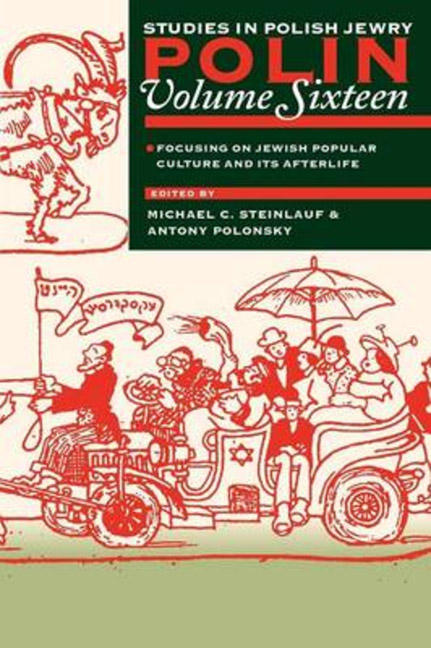Book contents
- Frontmatter
- Dedication
- Editors and Advisers
- Preface
- Polin
- Polin: Studies in Polish Jewry
- Contents
- Note on Place Names
- Note on Transliteration
- PART I JEWISH POPULAR CULTURE IN POLAND AND ITS AFTERLIFE
- IN PRE-WAR POLAND
- AFTERLIFE
- From ‘Madagaskar’ to Sachsenhausen: Singing about ‘Race’ in a Nazi Camp
- The Badkhn in Contemporary Hasidic Society: Social, Historical, and Musical Observations
- Transmigrations: Wolf Krakowski's Yiddish Worldbeat in its Socio-Musical Context
- ‘The Time of Vishniac’: Photographs of Pre-War East European Jewry in Post-War Contexts
- Repopulating Jewish Poland—in Wood
- The Kraków Jewish Culture Festival
- PART II DOCUMENTS
- PART III NEW VIEWS
- PART IV REVIEWS
- REVIEW ESSAYS
- BOOK REVIEWS
- CORRESPONDENCE
- OBITUARIES
- Notes on the Contributors
- Glossary
- Index
‘The Time of Vishniac’: Photographs of Pre-War East European Jewry in Post-War Contexts
from AFTERLIFE
- Frontmatter
- Dedication
- Editors and Advisers
- Preface
- Polin
- Polin: Studies in Polish Jewry
- Contents
- Note on Place Names
- Note on Transliteration
- PART I JEWISH POPULAR CULTURE IN POLAND AND ITS AFTERLIFE
- IN PRE-WAR POLAND
- AFTERLIFE
- From ‘Madagaskar’ to Sachsenhausen: Singing about ‘Race’ in a Nazi Camp
- The Badkhn in Contemporary Hasidic Society: Social, Historical, and Musical Observations
- Transmigrations: Wolf Krakowski's Yiddish Worldbeat in its Socio-Musical Context
- ‘The Time of Vishniac’: Photographs of Pre-War East European Jewry in Post-War Contexts
- Repopulating Jewish Poland—in Wood
- The Kraków Jewish Culture Festival
- PART II DOCUMENTS
- PART III NEW VIEWS
- PART IV REVIEWS
- REVIEW ESSAYS
- BOOK REVIEWS
- CORRESPONDENCE
- OBITUARIES
- Notes on the Contributors
- Glossary
- Index
Summary
IN the vast, charged array of post-Holocaust representations of pre-war Jewish life in eastern Europe, photographs seem to hold out a distinct promise of stability. Works of mechanical reproduction, they appear to offer an actuality that could rectify what personal recollections, communal lore, published memoirs, literary works, artistic renderings, songs, dramas, and even historical writings may have ‘manipulated’ or even ‘distorted’. But, as scholars of photography have discussed at great length, the verisimilitude of photography proves to be a false friend, as deceptive as it is engaging. Like any other art form, photography has its conventions, and the meaning of photographs is as contingent as that of any other works of art—perhaps even more so, in that photographs demand some kind of commentary or narration, title or inventory label, in order to be ‘read’.
No more telling illustration of this larger issue exists than the post-Holocaust presentation—in publications, films, or exhibitions—of photographs depicting east European Jews in the decades before their annihilation at the hands of Nazi Germany and its collaborators. Indeed, the post-war relationship with these photographs is rife with contradictory impulses: though highly selective and fragmentary by their very nature, they are prized as reanimating an entire ‘lost world’; routine, quotidian images now often loom large as archetypal. Frequently offering glimpses of east European Jewish life as seen from without, these photographs are approached as points of entry into these Jews’ inner life. Documents of actuality, they can—and now, almost inevitably, do—acquire mythic meanings. However, these contradictions do not compromise the value of these pre-war photographs and their post-war re-presentations. Rather, the contradictions provide a guide to understanding the larger cultural agendas at work in the many projects of remembrance that make use of these images.
In the century before the Second World War photography came to play an increasingly prominent role in representing east European Jews, both to themselves and to others. While the preponderance of photographs of this community were ones they either commissioned from local studio photographers or took themselves, there were also a wide variety taken by photographers from outside their communities. Especially important are the work of various professional photographers, both Jews and non-Jews, who took pictures as photo-journalists; as documentarians working for philanthropies, political parties, and other organizations; as government employees (taking photographs for identity cards, school records, etc.); or to provide images published on postcards.
- Type
- Chapter
- Information
- Focusing on Jewish Popular Culture and Its Afterlife , pp. 313 - 334Publisher: Liverpool University PressPrint publication year: 2003



